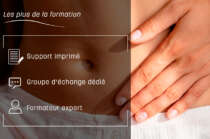 Marion VALLET, Sage-femme. Spécialiste en fertilité et sexualité.
Marion VALLET, Sage-femme. Spécialiste en fertilité et sexualité.
Physiologie de la fertilité et observation du cycle
La physiologie de la fertilité de la femme est très mal connue des professionnels de santé et amène à des prises en charge non optimales dans les troubles gynécologiques de la femme et dans l’hypofertilité.
Dans cette formation, après avoir approfondi le cycle ovulatoire physiologique, nous aborderons les différents biomarqueurs de la fertilité, tous les signes cliniques qui renseignent la femme sur ses phases fertiles et infertiles du cycle, nous préciserons les marqueurs paracliniques que sont la biologie et l’échographie et nous apprendrons à transmettre des outils précieux pour que la femme commence l’observation du cycle dans le but de comprendre et/ou de concevoir.
Pré-requis : posséder le diplôme du public concerné.
Public concerné et niveau de difficulté :
Kinésithérapeutes :
Ostéopathes :
Sages femmes :
Médecins :
- Approfondir l’anatomie de la femme en lien avec la fertilité.
- Comprendre le cycle ovulatoire sur le versant de l’hormonologie.
- Découvrir les cinq biomarqueurs cliniques du cycle ovulatoire.
- Comprendre les biomarqueurs paracliniques du cycle ovulatoire (biologiques et échographiques).
- Découvrir les différentes méthodes d’observation du cycle.
- Être capable de proposer l’observation du cycle aux femmes.
1 – Anatomie et histologie (de la femme et de l’homme).
2 – Hormonologie du cycle ovulatoire
- L’axe hypothalamo-hypophysaire
- L’axe gonadotrope
- La physiologie du cycle en quatre temps
- L’équilibre œstro-progestatif.
3 – Clinique du cycle ovulatoire : les biomarqueurs
- Le mucus cervical
- La température basale du corps
- La position du col
- L’œdème vulvaire et le ganglion lymphatique
- Les saignements physiologiques.
4 – Paraclinique du cycle ovulatoire
- Repères biologiques
- Repères échographiques.
5 – Fertilité du coupe et hygiène de vie.
6 – Méthodes d’observation du cycle : MOC
- Historique des MOC
- Les différentes MOC et leurs spécificités
- Proposer l’observation du cycle pour concevoir
- Valeur médicale du tableau d’observation du cycle
- Méthodologie du cycle ovulatoire fertile
- Cas cliniques.
Bibliographie des MOC : vue d’ensemble des MOC (méthodes d’observation du cycle ou méthodes basées sur la connaissance de la fertilité)
- Klaus, H., Natural family planning: a review. Obstet Gynecol Surv 1982, 37 (2), 128-50.
PubMed - Manhart, M.D., Duane, M., Linda, A., Sinai, I., Golden-Tevald J. Fertility awareness-based methods of family planning: A review of effectiveness for avoiding pregnancy using SORT, Osteopathic Family Physician, 2013, 5(1), 2-8.
Abstract Article - Mikolajczyk, R.T., Stanford, J.B., & Rauchfuss, M. Factors influencing the choice to use modern natural family planning, Contraception. 2002, 67, 253-258.
PubMed - Pallone, S.R., Burgus, G.R. Fertility Awareness-based Methods: Another Option for Family Planning, J Am Board Fam Med. 2009, 22(2):147-57.
PubMed Article - Smoley, B. A.; Robinson, C. M., Natural family planning. Am Fam Physician 2012, 86 (10), 924-8.
PubMed Article
Physiologie de la fertilité
- Billings, E.L. & Westmore, A. (2011). The Billings Method (9th ed.). Melbourne, Australia: Anne O’Donovan Publishing.
- Brown, J.B. (2011). Types of ovarian activity in women and their significance: the continuum (a reinterpretation of early findings). Human Reproduction Update, 17(2), 141-158. http://humupd.oxfordjournals.org/content/17/2/141.full.pdf+html
- Odeblad, E. (2010). Contributions of Cervical Mucus and Vestibular Factors to Peak Sensation. Bulletin of OMR&RCA, 37(2), 2-8.
- Odeblad, E. (2009). Some Additional Aspects of the Physiology of the Mucus Symptom. Bulletin of OMR&RCA, 36(3), 2-7.
- Odeblad, E. (2009). The Possible Existence and Role of Mucus-like Secretion in the Vulvar Region. Bulletin of OMR&RCA, 36(2), 2-4.
- Corkill M., & Marshell M. (2008, December 19). Natural fertility regulation – the Billings Ovulation Method. Australian Doctor, How to Treat.
- Click here for the Australian Doctor article
- Vigil P., Ceric, F., Cortes, M., & Klaus, H. (2006). Usefulness of Monitoring Fertility from Menarche. Journal of Pediatric and Adolescent Gynecology, 19(3), 173-179.
- Ceric, F., Silva, D., & Vigil, P. (2005). Ultrastructure of the human periovulatory cervical mucus. Journal of Electron Microscopy, 54(5): 479-484.
- 10.Blackwell, L.F., Brown, J.B., Vigil, P., Gross, B., Sufi, S., & d’Argangues, C. (2003). Hormonal monitoring of ovarian activity using the Ovarian Monitor. Part I. Validation of home and laboratory results obtained during ovulatory cycles by comparison with radio immunoassay. Steroids, 68(5), 465-476.
- 11.Menarguez, M., Pastor, L.M., & Odeblad, E. (2003). Morphological characterization of different human cervical mucus types using light and scanning electron microscopy. Human Reproduction, 18(9), 1782-1789.
- 12.Odeblad, E. (2002). Investigations on the Physiological Basis for Fertility Awareness. Bulletin of OMR&RCA, 29(1), 2-11.
- 13.Odeblad, E. (1997). Cervical mucus and their function. Journal of the Irish Colleges of Physicians and Surgeons 26(1), 27-32.
- 14.Odeblad, E. (1994). The discovery of different types of cervical mucus and the Billings Ovulation Method. Bulletin of the Natural Family Planning Council of Victoria, 21(3), 3-34.
- 15.Morales, P., Rocco, M., & Vigil, P. (1993). Human cervical mucus relationship between biochemical characteristics and ability to allow migration of spermatozoa. Human Reproduction, 8(1), 78-83.
- 16.Blackwell, L.F., & Brown, J.B. (1992). Application of time-series analysis for the recognition of increases in urinary estrogens as markers for the beginning of the potentially fertile period. Steroids, 57(11), 554-562.
- 17.Vigil, P., Perez, A., Neira, J., & Morales, P. (1991). Post-partum cervical mucus: biological and rheological properties. Human Reproduction 6(4), 475-479.
- 18.Brown, J.B., Blackwell, L.F., Holmes, J., & Smyth, K. (1989). New assays for identifying the fertile period. Supplement to International Journal of Gynecology and Obstetrics, 1, 111-128.
- 19.Barros, C., Arguello, B., Jedlicki, A., Vigil, P. & Herrera, E. (1985). Scanning electron microscope study on human cervical mucus. Gamete Research, 12(1), 85-89.
- 20.Brown, J.B., Harrisson, P., & Smith, M.A. (1985). A study of returning fertility after childbirth, during lactation, by measurement of urinary oestrogen and pregnanediol excretion and cervical mucus production. Journal of Biosocial Science Supplement, 9, 5-23.
- 21.Brown, J.B. (1981). Correlation between the mucus symptoms and the hormonal markers of fertility throughout reproductive life. Melbourne, Australia: Advocate Press.
- 22.Odeblad, E. (1977). Physical properties of cervical mucus. In M. Elstein & D.V. Parke (Eds.), Mucus in Health and Disease (pp. 217-225). New York: Plenum Press.
- 23.Billings, E.L., Billings, J.J., Brown, J.B., & Burger, H.G. (1972). Symptoms and hormonal changes accompanying ovulation. Lancet, 299(7745), 282-284.
- 24.Odeblad, E. (1968). The functional structure of human cervical mucus. Acta Obstetricia et Gynecologica Scandinavica, 47(S1), 57-79.
- 25.Odeblad, E. (1960). Discussion: The physics of the cervical mucus. Acta Obstetricia et Gynecologica Scandinavica, 39(S1), 126-127.
- 26.Odeblad, E. (1959). The physics of the cervical mucus. Acta Obstetricia et Gynecologica Scandinavica, 38(S1), 44-58.
Efficacité des méthodes basées sur la sensibilisation à la fertilité naturelle ou à la fécondité
- 26.Qian, S.Z., Zhang, D.W, Zuo, H.Z, Lu, R.K., Peng, L., & He, C.H. (2000). Evaluation of the Effectiveness of a Natural Fertility Regulation Programme in China. Bulletin of OMR&RCA, 27(4), 17-22.
- 27.Indian Council of Medical Research Task Force on Natural Family Planning. (1996). Field Trial of Billings Ovulation Method of Natural Family Planning. Contraception, 53(2), 69-74.
- 28.Thapa, S., Wonga, M.V., Lampe, P.G., Pietojo, H., & Soejoenoes, A. (1990). Efficacy of Three Variations of Periodic Abstinence for Family Planning in Indonesia. Studies in Family Planning, 21(6), 327-334.
- 29.World Health Organisation. (1984). Prospective multicentre trial of the Ovulation Method of Natural Family Planning IV. The Outcome of Pregnancy. Fertility and Sterility, 41, 593-598.
- 30.World Health Organisation. (1983). Prospective multicentre trial of the Ovulation Method of Natural Family Planning III. Characteristics of the Menstrual Cycle and of the Fertile Phase. Fertility and Sterility, 40, 773-778.
- 31.World Health Organisation. (1981). Prospective multicentre trial of the Ovulation Method of Natural Family Planning II. The Effectiveness Phase. Fertility and Sterility, 36, 591-598.
- 32.World Health Organisation Task Force on Methods for the Determination of the Fertile Period, Special Programme of Research, Development and Research Training in Human Reproduction. (1981). Prospective multicentre trial of the Ovulation Method of Natural Family Planning. I. The Teaching Phase. Fertility and Sterility, 36, 152-158.
- 33.Weissman, M.C., Foliaki, J., Billings, E.L., & Billings, J.J. (1972). A Trial of the Ovulation Method of family planning in Tonga. Lancet, 300, 813-816.
- 34.Arevalo, M.; Jennings, V.; Nikula, M.; Sinai, I., Efficacy of the new TwoDay Method of family planning. Fertil Steril 2004, 82 (4), 885-92.
PubMed Article - Arevalo, M.; Jennings, V.; Sinai, I., Efficacy of a new method of family planning: the Standard Days Method. Contraception 2002, 65 (5), 333-8.
PubMed Article - Bhargava, H.; Bhatia, J. C.; Ramachandran, L.; Rohatgi, P.; Sinha, A., Field trial of billings ovulation method of natural family planning. Contraception 1996, 53 (2), 69-74.
PubMed - Fehring, R. J.; Schneider, M.; Raviele, K.; Barron, M. L., Efficacy of cervical mucus observations plus electronic hormonal fertility monitoring as a method of natural family planning. J Obstet Gynecol Neonatal Nurs 2007, 36 (2), 152-60.
PubMed - Fehring, R.J., Schneider, M., Raviele, K., Rodriguez, D., Pruszynski, J. Randomized comparison of two Internet-supported fertility-awareness-based methods of family planning, Contraception 2013, 88(1), 24-30.
PubMed - Fehring, R., Lawrence, D., Philpot, C. Use effectiveness of the Creighton model ovulation method of natural family planning, J Obstet Gynecol Neonatal Nurs 1994, 23(4), 303-312.
PubMed Article - Fehring, R.J., Schneider, M., Barron, M.L., Prezsynski, J. Influence of motivation on the efficacy of natural family planning, Am J Mat Child Nursing 2013, 38(6):352-8.
PubMed Article - Frank-Herrmann, P.; Freundl, G.; Gnoth, C.; Godehardt, E.; Kunert, J.; Baur, S.; Sottong, U., Natural family planning with and without barrier method use in the fertile phase: efficacy in relation to sexual behavior: a German prospective long-term study. Adv Contracept 1997, 13 (2-3), 179-89.
PubMed - Frank-Herrmann, P.; Heil, J.; Gnoth, C.; Toledo, E.; Baur, S.; Pyper, C.; Jenetzky, E.; Strowitzki, T.; Freundl, G., The effectiveness of a fertility awareness based method to avoid pregnancy in relation to a couple’s sexual behaviour during the fertile time: a prospective longitudinal study. Hum Reprod 2007, 22 (5), 1310-9.
PubMed Article - Gnoth, C.; Godehardt, D.; Godehardt, E.; Frank-Herrmann, P.; Freundl, G., Time to pregnancy: results of the German prospective study and impact on the management of infertility. Hum Reprod 2003, 18 (9), 1959-66.
PubMed Article - Hilgers, T. W.; Daly, K. D.; Prebil, A. M.; Hilgers, S. K., Cumulative pregnancy rates in patients with apparently normal fertility and fertility-focused intercourse. J Reprod Med 1992, 37(10), 864-6.
PubMed - Hilgers, T. W.; Stanford, J. B., Creighton Model NaProEducation Technology for avoiding pregnancy. Use effectiveness. J Reprod Med 1998, 43 (6), 495-502.
PubMed - Howard, M. P.; Stanford, J. B., Pregnancy probabilities during use of the Creighton Model Fertility Care System. Arch Fam Med 1999, 8 (5), 391-402.
PubMed Article - Lamprecht, V.; Trussell, J., Natural family planning effectiveness: evaluating published reports. Adv Contracept 1997, 13 (2-3), 155-65.
PubMed - Manhart, M.D., Duane, M., Linda, A., Sinai, I., Golden-Tevald, J. Fertility awareness-based methods of family planning: A review of effectiveness for avoiding pregnancy using SORT, Osteopathic Family Physician 2013, 5(1), 2-8.
Abstract Article - Robinson, J. E.; Wakelin, M.; Ellis, J. E., Increased pregnancy rate with use of the Clearblue Easy Fertility Monitor. Fertil Steril 2007, 87 (2), 329-34.
PubMed - Sinai, I.; Cachan, J., A Bridge for postpartum women to Standard Days Method(R): II. Efficacy study. Contraception 2012, 86 (1), 16-21.
PubMed - Sinai, I.; Jennings, V.; Arévalo, M., The importance of screening and monitoring: the Standard Days Method and cycle regularity. Contraception 2004, 69 (3), 201-6.
PubMed Article - Stanford, J. B.; Parnell, T. A.; Boyle, P. C., Outcomes from treatment of infertility with natural procreative technology in an Irish general practice. J Am Board Fam Med 2008, 21 (5), 375-84.
PubMed Article - Tham, E.; Schliep, K.; Stanford, J., Natural procreative technology for infertility and recurrent miscarriage: outcomes in a Canadian family practice. Can Fam Physician 2012, 58 (5), e267-74.
PubMed Article - Trussell, J.; Grummer-Strawn, L., Contraceptive failure of the ovulation method of periodic abstinence. Fam Plann Perspect 1990, 22 (2), 65-75.
PubMed - Trussell, J.; Grummer-Strawn, L., Further analysis of contraceptive failure of the ovulation method. Am J Obstet Gynecol 1991, 165 (6 Pt 2), 2054-9.
PubMed - Warniment, C. B.; Hansen, K., Is natural family planning a highly effective method of birth control? Yes: natural family planning is highly effective and fulfilling. Am Fam Physician2012, 86 (10), 1-2.
PubMed Article - [World Health Organization] A prospective multicentre trial of the ovulation method of natural family planning. II. The effectiveness phase. Fertil Steril 1981, 36 (5), 591-8.
PubMed
L’ovulation et le cycle menstruel
- American Academy of Pediatrics Committee on Adolescence, American College of Obstetricians and Gynecologists Committee on Adolescent Health Care, Diaz, A., Laufer, M.R., Breech, L.L. Clinical report: Menstruation in girls and adolescents: Using the menstrual cycle as a vital sign. Pediatrics, 2006, 118(5), 2245-2250.
PubMed Article - Cohen, M. R.; Stein, I. F., Sr.; Kaye, B. M., Spinnbarkeit: a characteristic of cervical mucus; significance at ovulation time. Fertil Steril 1952, 3 (3), 201-9.
PubMed - Vigil, P., Ceric, F., Cortes, M.E., Klaus, H. Usefulness of monitoring fertility from menarche. J Ped and Adol Gynecology 2006, 19, 172-179.
PubMed Article - Wilcox, A. J.; Weinberg, C. R.; Baird, D. D., Post-ovulatory ageing of the human oocyte and embryo failure. Hum Reprod 1998, 13 (2), 394-7.
PubMed Article - Wilcox, A. J.; Weinberg, C. R.; Baird, D. D., Timing of sexual intercourse in relation to ovulation. Effects on the probability of conception, survival of the pregnancy, and sex of the baby.N Engl J Med 1995, 333 (23), 1517-21.
PubMed Article
Publications scientifiques de planification familiale naturelle
- Cibula, D.; Gompel, A.; Mueck, A. O.; La Vecchia, C.; Hannaford, P. C.; Skouby, S. O.; Zikan, M.; Dusek, L., Hormonal contraception and risk of cancer. Hum Reprod Update 2010, 16 (6), 631-50.
- Gnoth, C.; Frank-Herrmann, P.; Schmoll, A.; Godehardt, E.; Freundl, G., Cycle characteristics after discontinuation of oral contraceptives. Gynecol Endocrinol 2002, 16 (4), 307-17.
PubMed - Higgins, J. E.; Wilkens, L. R., Statistical comparison of Pearl rates. Am J Obstet Gynecol 1985, 151 (5), 656-9.
PubMed - Kahlenborn, C.; Stanford, J. B.; Larimore, W. L., Postfertilization effect of hormonal emergency contraception. Ann Pharmacother 2002, 36 (3), 465-70.
PubMed Article - Heffron, R.; Donnell, D.; Rees, H.; Celum, C.; Mugo, N.; Were, E.; de Bruyn, G.; Nakku-Joloba, E.; Ngure, K.; Kiarie, J.; Coombs, R. W.; Baeten, J. M., Use of hormonal contraceptives and risk of HIV-1 transmission: a prospective cohort study. Lancet Infect Dis 2012, 12 (1), 19-26.
PubMed Article - Morrison, C. S.; Nanda, K., Hormonal contraception and HIV: an unanswered question. Lancet Infect Dis 2012, 12 (1), 2-3.
PubMed Article - Morrison, C. S.; Bright, P.; Wong, E. L.; Kwok, C.; Yacobson, I.; Gaydos, C. A.; Tucker, H. T.; Blumenthal, P. D., Hormonal contraceptive use, cervical ectopy, and the acquisition of cervical infections. Sex Transm Dis 2004, 31 (9), 561-7.
PubMed Article - Mosher, W. D.; Martinez, G. M.; Chandra, A.; Abma, J. C.; Willson, S. J., Use of contraception and use of family planning services in the United States: 1982-2002. Adv Data 2004, (350), 1-36.
PubMed Article - Stanford, J. B.; Larimore, W., Informed consent for postfertilization effects of hormonal and surgical forms of birth control for women. Arch Fam Med 2000, 9 (8), 690-1. PubMed
- Wilcox A. J., Baird D. B., Weinberg C. R., Time of implantation of the conceptus and loss of pregnancy. N Engl J Med 1999, 340, 1796-9.
PubMed Article
Allaitement et PFN/MOC
- Kennedy, K. I.; Kotelchuck, M., Policy considerations for the introduction and promotion of the lactational amenorrhea method: advantages and disadvantages of LAM. J Hum Lact 1998, 14 (3), 191-203.
PubMed - Labbok, M. H.; Hight-Laukaran, V.; Peterson, A. E.; Fletcher, V.; von Hertzen, H.; Van Look, P. F., Multicenter study of the Lactational Amenorrhea Method (LAM): I. Efficacy, duration, and implications for clinical application. Contraception 1997, 55 (6), 327-36.
PubMed - Peterson, A. E.; Perez-Escamilla, R.; Labbok, M. H.; Hight, V.; von Hertzen, H.; Van Look, P., Multicenter study of the lactational amenorrhea method (LAM) III: effectiveness, duration, and satisfaction with reduced client-provider contact. Contraception 2000, 62 (5), 221-30.
PubMed
Aspects psycho/sociaux de la PFN/MOC
- France, M., France, J., Townend. K. Natural family planning in New Zealand: a study of continuation rates and characteristics of users. Adv Contracept. 1997, 13, 191-198.
PubMed - Grimes, D. A.; Gallo, M. F.; Grigorieva, V.; Nanda, K.; Schulz, K. F., Fertility awareness-based methods for contraception: systematic review of randomized controlled trials. Contraception 2005, 72 (2), 85-90.
PubMed - Klann, N.; Hahlweg, K.; Hank, G., Psychological aspects of NFP practice. Int J Fertil 1988, 33 Suppl, 65-9.
PubMed - Vande Vusse, L.; Hanson, L.; Fehring, R. J.; Newman, A.; Fox, J., Couples’ views of the effects of natural family planning on marital dynamics. J Nurs Scholarsh 2003, 35 (2), 171-6.
PubMed
Programme de formation aux MOC et éducation
- Beeman, P. Natural Family Planning in Education and Practice: A Narrative Review of the Literature, The Linacre Quarterly 2010, 77(4), 399–414.
Abstract - Fehring, R. J.; Schneider, M.; Raviele, K., Pilot evaluation of an internet-based natural family planning education and service program. J Obstet Gynecol Neonatal Nurs 2011, 40 (3), 281-91.
PubMed - Lundsberg, L. S.; Pal, L.; Gariepy, A. M.; Xu, X.; Chu, M. C.; Illuzzi, J. L., Knowledge, attitudes, and practices regarding conception and fertility: a population-based survey among reproductive-age United States women. Fertil Steril 2014, 101 (3), 767-74.
PubMed - Stanford, J. B.; Lemaire, J. C.; Thurman, P. B., Women’s interest in natural family planning. J Fam Pract 1998, 46 (1), 65-71.
PubMed - Stanford JB, Thurman PB, Lemaire JC.. Physicians’ knowledge and practices regarding natural family planning., LWW:Obstet Gynecol. 1999 Nov;94(5 Pt 1):672-8.
PubMed - Stanford, J. B.; Lemaire, J. C.; Fox, A., Interest in natural family planning among female family practice patients. Fam Pract Res J 1994, 14 (3), 237-49.
PubMed - Steinauer J., LaRochelle, F., Rowh, M., Backus, L., Sandahl, Y., Foster, A. First impressions: what are preclinical medical students in the US and Canada learning about sexual and reproductive health? Contraception 2009, 80(1), 74-80.
PubMed
Divers
- Les fiches individuelles sont stockées sur support numérique et sur papier.
- Un rapport annuel d’activité est envoyé à l’ANDPC.
- Un bilan pédagogique et financier annuel est envoyé à la DREETS (art. R6352-23 et 22 du code du travail).
 Marion VALLET – Sage femme
Marion VALLET – Sage femme
Master I universitaire fertilité et sexualité.
Master I universitaire d’éthique biomédicale.
Formation d’animatrice TeenSTAR, parcours d’éducation affective et sexuelle des jeunes.
Crédit d’impôt pour la formation des dirigeants d’entreprise : Cliquer ici.
Accès immédiat et permanent à la formation après règlement.
Pour le règlement :
- Chèque libellé à l’ordre de Kiné Formations et à adresser à : “KINÉ FORMATIONS” BP. 60254 – 08104 Charleville-Mézières.
- Carte bancaire.
- Virement (RIB sur demande).











Avis
Il n’y a pas encore d’avis.